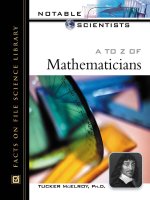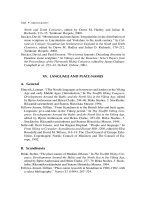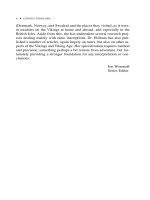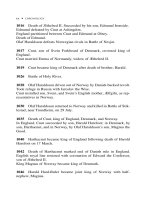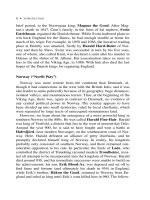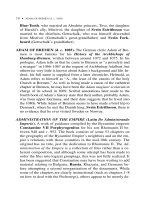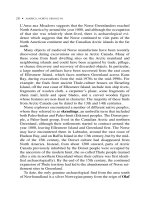Internet of things a to z technologies and applications part 1
Bạn đang xem bản rút gọn của tài liệu. Xem và tải ngay bản đầy đủ của tài liệu tại đây (14.6 MB, 324 trang )
Internet of Things A to Z
IEEE Press
445 Hoes Lane
Piscataway, NJ 08854
IEEE Press Editorial Board
Ekram Hossain, Editor in Chief
Giancarlo Fortino
David Alan Grier
Donald Heirman
Xiaoou Li
Andreas Molisch
Saeid Nahavandi
Ray Perez
Jeffrey Reed
Linda Shafer
Mohammad Shahidehpour
Sarah Spurgeon
Ahmet Murat Tekalp
Internet of Things A to Z
Technologies and Applications
Edited by Qusay F. Hassan
Copyright 2018 by The Institute of Electrical and Electronics Engineers, Inc. All rights
reserved.
Published by John Wiley & Sons, Inc., Hoboken, New Jersey.
Published simultaneously in Canada.
No part of this publication may be reproduced, stored in a retrieval system, or transmitted in any
form or by any means, electronic, mechanical, photocopying, recording, scanning, or otherwise,
except as permitted under Section 107 or 108 of the 1976 United States Copyright Act, without
either the prior written permission of the Publisher, or authorization through payment of the
appropriate per-copy fee to the Copyright Clearance Center, Inc., 222 Rosewood Drive, Danvers,
MA 01923, (978) 750-8400, fax (978) 750-4470, or on the web at www.copyright.com. Requests to
the Publisher for permission should be addressed to the Permissions Department, John Wiley &
Sons, Inc., 111 River Street, Hoboken, NJ 07030, (201) 748-6011, fax (201) 748-6008, or online at
/>Limit of Liability/Disclaimer of Warranty: While the publisher and author have used their best
efforts in preparing this book, they make no representations or warranties with respect to the
accuracy or completeness of the contents of this book and specifically disclaim any implied
warranties of merchantability or fitness for a particular purpose. No warranty may be created or
extended by sales representatives or written sales materials. The advice and strategies contained
herein may not be suitable for your situation. You should consult with a professional where
appropriate. Neither the publisher nor author shall be liable for any loss of profit or any other
commercial damages, including but not limited to special, incidental, consequential, or other
damages.
For general information on our other products and services or for technical support, please
contact our Customer Care Department within the United States at (800) 762-2974, outside the
United States at (317) 572-3993 or fax (317) 572-4002.
Wiley also publishes its books in a variety of electronic formats. Some content that appears in
print may not be available in electronic formats. For more information about Wiley products, visit
our web site at www.wiley.com.
Library of Congress Cataloging-in-Publication Data is available.
ISBN: 978-1-111-945674-2
Printed in the United States of America.
10 9 8 7 6
5 4 3
2 1
v
Table of Contents
Preface xix
Acknowledgments xxv
Contributors xxvii
Part I Concepts and Perspectives
1
1
Introduction to the Internet of Things
Detlef Schoder
1.1
1.2
1.2.1
1.2.2
Introduction 3
Internet of Things Concepts 7
Core Concepts: Smart Objects and Smart Environments 7
Related Concepts: Machine-to-Machine Communications,
Industrial Internet of Things, and Industry 4.0 8
Machine-to-Machine Communications 9
Industrial Internet and Industry 4.0 10
Who Works on the Internet of Things? 11
Internet of Things Framework 12
Information and Communication Technology Infrastructure 14
Architecture and Reference Models 14
Networks and Connectivity 16
Embedding 19
Sensors 22
Actuators 24
Power Supply 24
Identification 25
Radio Frequency Identification 25
Addressing Schemes Based on IPv6 and Electronic
Product Code 27
Localization 28
1.2.2.1
1.2.2.2
1.3
1.4
1.5
1.5.1
1.5.2
1.5.3
1.5.4
1.5.5
1.5.6
1.5.7
1.5.7.1
1.5.7.2
1.5.8
3
vi
Table of Contents
1.5.9
1.6
1.6.1
1.6.2
1.6.2.1
1.6.2.2
1.6.3
1.7
1.7.1
1.7.2
1.7.3
1.8
1.8.1
1.8.2
1.8.3
1.8.4
1.9
Cloud Computing and Fog Computing 29
Derived Qualities of Modern ICT 31
Context Awareness, Adaptability, and Proactivity 31
Increased Data Quality 32
Dimensions of Data Quality 32
Effects of Increased Data Quality 33
Intuitive Interaction 33
Potential for Product, Process, and Business Model Innovations
Product Innovation 35
Process Innovation 36
Business Model Innovation 37
Implications and Challenges 38
New Markets 38
Changed Value Creation 39
Increased Awareness for Information Spaces 40
Social, Ethical, Legal, and Risk Aspects 41
Conclusion 44
References 45
2
Environment, People, and Time as Factors in the Internet of Things
Technical Revolution 51
Jan Sliwa
2.1
2.2
2.2.1
2.2.2
2.3
2.4
2.4.1
2.4.2
2.5
2.5.1
2.5.2
2.5.3
2.5.4
2.5.5
2.6
2.6.1
2.6.2
2.6.3
2.6.4
2.6.5
2.6.6
Introduction 51
Technical Revolutions 52
Past Experience 52
Internet of Things as a Technical Revolution
Cyber–Physical–Social Systems 54
Environment 56
Physical Environment 56
Other Technical Systems 57
Time 58
Changing Goals and Values 58
Interoperability Degradation 59
Long-Term Support 60
Erosion and Economy 61
Transferring Adaptable Objects 62
People 63
Users 63
Developers 63
Supporters 65
Project Managers 65
Manufacturers 66
Regulators 66
53
34
Table of Contents
2.7
2.8
2.9
2.10
2.11
Cybersecurity 67
Reasoning from Data 69
Adaptable Self-Organizing Systems
Moral Things 72
Conclusion 74
References 75
Part II
Enablers
70
77
3
An Overview of Enabling Technologies for the Internet of Things
Faisal Alsubaei, Abdullah Abuhussein, and Sajjan Shiva
3.1
3.2
3.3
3.3.1
3.3.1.1
3.3.1.2
3.3.1.3
3.3.2
3.3.2.1
3.3.2.2
3.3.2.3
3.3.2.4
3.3.3
3.3.3.1
3.3.3.2
3.3.3.3
3.3.4
3.3.4.1
3.3.4.2
3.3.4.3
3.3.4.4
3.3.5
3.3.5.1
3.3.5.2
3.4
3.5
Introduction 79
Overview of IoT Architecture 80
Enabling Technologies 81
Perception Layer Technologies 81
Passive 82
Semipassive 83
Active 83
Network Layer Technologies 84
Identification 84
Communication 86
Security 92
Routing 92
Middleware Technologies 93
Service Discovery 94
Data Exchange 95
Computation 98
Application Layer Technologies 100
Identity-Related Services 100
Information Aggregation Services 101
Collaborative Aware Services 101
Ubiquitous Services 101
Business Layer Technologies 101
Semantics 101
Big Data Analytics 103
IoT Platforms and Operating Systems 105
Conclusion 108
References 109
4
Cloud and Fog Computing in the Internet of Things
Daniel Happ
4.1
Introduction
113
113
79
vii
viii
Table of Contents
4.2
4.3
4.3.1
4.3.2
4.3.2.1
4.3.2.2
4.3.2.3
4.3.3
4.4
4.4.1
4.4.2
4.4.2.1
4.4.2.2
4.4.2.3
4.4.2.4
4.4.2.5
4.4.2.6
4.4.2.7
4.4.2.8
4.4.3
4.4.3.1
4.4.3.2
4.4.3.3
4.4.4
4.5
IoT System Requirements 114
Cloud Computing in IoT 116
Advantages of Using the Cloud for IoT 118
Examples of Cloud-Based IoT 119
Industrial Domain 119
Smart Cities 119
Health/Well-Being 120
Key Challenges of Cloud-Based IoT 121
Fog Computing in IoT 122
Advantages of Using the Fog for IoT 124
Potential Future Fog Use Cases in the IoT 125
Smart Grid 125
Connected Vehicles 126
Education 126
Health Care 126
Smart Buildings 127
Surveillance 127
Wearables 127
Virtual Reality 128
Examples of Fog-Based IoT 128
Industrial Domain 128
Smart Cities 128
Health/Well-Being 129
Key Challenges of Fog-Based IoT 130
Conclusion 131
References 132
5
RFID in the Internet of Things 135
Akaa Agbaeze Eteng, Sharul Kamal Abdul Rahim,
and Chee Yen Leow
5.1
5.2
5.3
5.3.1
5.3.2
5.3.3
5.3.4
Introduction 135
Historical Perspective 135
RFID and the Internet of Things 137
Object Identification using RFID 139
RFID Sensors 140
RFID Sensor Localization 141
Connecting RFID Sensors to the
Internet 142
Emergent Issues 144
Conclusion 146
References 146
5.4
5.5
Table of Contents
6
A Tutorial Introduction to IoT Design and Prototyping with
Examples 153
Manuel Meruje, Musa Gwani Samaila, Virginia N. L. Franqueira,
Mário Marques Freire, and Pedro Ricardo Morais Inácio
6.1
6.2
6.2.1
6.2.1.1
6.2.1.2
6.2.1.3
Introduction 153
Main Features of IoT Hardware Development Platforms 154
Key Features of Arduino Hardware Development Platforms 155
Processing and Memory/Storage Capacity 155
Power Consumption, Size, and Cost of Arduino Boards 157
Operating Systems and Programming Languages for
Arduino Boards 159
Connectivity and Flexibility/Customizability of Peripherals of the
Arduino Boards 160
Onboard Sensors and Hardware Security Features of Arduino
Boards 161
Major Features of the Raspberry Pi Hardware Platforms 163
Processing and Memory/Storage Capacity 163
Power Consumption, Size, and Cost of Raspberry Pi Hardware
Platforms 165
Operating Systems and Programming Languages for
Raspberry Pi 166
Connectivity and Flexibility/Customizability of Peripherals of the
Raspberry Pi 167
Onboard Sensors and Hardware Security Features of
Raspberry Pi 168
Design and Prototyping of IoT Applications 169
IoT Design and Prototyping Using Arduino Boards 169
IoT Design and Prototyping using Raspberry Pi Platforms 172
Projects on IoT Applications 173
An Arduino Project for IoT Application 173
Installing the Arduino IDE and Mosquitto Software 173
Using Arduino IDE and Downloading Libraries 174
Project Source Code and Arduino Wiring Diagram 176
Executing Mosquitto and Testing the Application 177
A Raspberry Pi Project for IoT Application 180
Installing the Operating System 180
Downloading and Installing the Required Packages 180
Constructing and Testing the Circuit 182
Development and Testing of a Python Web Application 183
Conclusion 184
Acknowledgments 185
References 185
6.2.1.4
6.2.1.5
6.2.2
6.2.2.1
6.2.2.2
6.2.2.3
6.2.2.4
6.2.2.5
6.3
6.3.1
6.3.2
6.4
6.4.1
6.4.1.1
6.4.1.2
6.4.1.3
6.4.1.4
6.4.2
6.4.2.1
6.4.2.2
6.4.2.3
6.4.2.4
6.5
ix
x
Table of Contents
7
On Standardizing the Internet of Things and Its Applications
Kai Jakobs
7.1
7.2
7.2.1
7.2.2
7.2.3
7.3
7.4
7.4.1
7.4.2
7.4.3
7.4.4
7.5
7.6
Introduction 191
Current Status 193
IoT Standardization 194
IoT-Based Applications 197
Security and Privacy 197
The Standardization Environment 199
Standardization in Selected Application Areas 201
Intelligent Transport Systems (Automotive Sector) 201
Smart Manufacturing 205
Smart Grid 206
Smart Cities 208
Discussion and Some Speculation 210
Conclusion 213
Acknowledgments 214
References 214
Part III Security Issues and Solutions
191
219
8
Security Mechanisms and Technologies for Constrained IoT
Devices 221
Marco Tiloca and Shahid Raza
8.1
8.2
8.2.1
8.2.2
8.2.3
8.2.4
8.2.5
8.2.6
8.2.7
8.3
8.3.1
8.3.2
8.3.3
8.3.4
8.3.5
8.3.6
8.4
Introduction 221
Security in IoT Protocols and Technologies 222
Lightweight Formats for Cryptosecurity Protocols 223
CoAP and DTLS 224
Object Security for Constrained RESTful Environments 227
Compressed IPsec 228
IEEE 802.15.4 and Bluetooth Low Energy 230
OAUTH-Based Authorization in the IoT 233
Overview of Security Protocols and Mechanisms in the IoT 234
Security Issues and Solutions 234
Denial-of-Service Against CoAP 235
Denial-of-Service and Scalability Issues in DTLS 238
DTLS-Based Group Communication 240
Efficient and Scalable Group Key Management 241
Selective Jamming in Wireless Networks 243
Intrusion Detection Systems and Firewalls 246
Conclusion 247
References 248
Table of Contents
9
Blockchain-Based Security Solutions for IoT Systems
Göran Pulkkis, Jonny Karlsson, and Magnus Westerlund
9.1
9.2
9.2.1
9.2.2
9.3
9.4
9.5
Introduction 255
Regulatory Requirements 256
General Data Protection Regulation 257
Directive on Security of Network and Information Systems 258
Blockchain Technology 259
Blockchains and IoT Systems 261
Examples of Blockchain-Based Security Solutions for IoT
Systems 262
Secure Management of IoT Devices 262
Secure Firmware Updates in IoT Devices 263
Trust Evaluation of a Trusted Computing Base in IoT Devices 264
IoT Device Identity Validation 265
Secure Data Store System for Access Control Information 266
Blockchain-Based Security Architecture for IoT Devices in Smart
Homes 266
Improved Reliability of Medical IoT Devices 269
Challenges and Future Research 270
Conclusions 270
References 271
9.5.1
9.5.2
9.5.3
9.5.4
9.5.5
9.5.6
9.5.7
9.6
9.7
10
The Internet of Things and IT Auditing 275
John Shu, Jason M. Rosenberg, Shambhu Upadhyaya, and
Hejamadi Raghav Rao
10.1
10.2
10.2.1
10.2.2
10.2.3
10.2.4
10.2.5
10.2.6
10.3
10.3.1
10.3.2
10.3.3
10.3.4
10.4
10.4.1
10.4.2
10.4.3
10.5
Introduction 275
Risks Associated with IoT 276
Privacy 277
Confidentiality, Integrity, and Availability
Identity Management 278
Physical Attacks 279
Cloud Infrastructure Attacks 279
Malware Attacks 279
IT Auditing 279
IoT Auditing 280
Need for Auditing 280
Risk Identification and Assessment 282
Audit Strategy 283
Use Cases of IoT in IT Auditing 286
Bring Your Own Devices 286
Electronic Utility Meter Readers 286
Smart Parking Meter Interfaces 286
Protecting the Business Network 287
278
255
xi
xii
Table of Contents
10.5.1
10.5.2
10.6
Traditional Security Measures 288
New Policies to Address New Threats
Conclusion 289
Acknowledgments 290
References 290
Part IV Application Domains
289
293
11
The Industrial Internet of Things
Alexander Willner
11.1
11.2
11.2.1
11.2.2
11.2.3
11.2.4
11.2.5
11.3
11.3.1
11.3.2
11.3.3
11.4
11.4.1
11.4.2
11.5
Introduction 295
Market Overview 296
Energy 297
Health care 298
Manufacturing 299
Smart Cities 301
Transportation 302
Interoperability and Technologies 303
Connectivity 304
Communication 305
Data Exchange 306
Alliances 309
Industrial Internet Consortium 309
Plattform Industrie 4.0 311
Conclusions 314
Acknowledgments 314
References 315
12
Internet of Things Applications for Smart Cities
Daniel Minoli and Benedict Occhiogrosso
12.1
12.2
12.3
12.3.1
12.3.2
12.3.3
12.3.4
12.3.5
12.4
Introduction 319
IoT Applications for Smart Cities 321
Specific Smart City Applications 330
Driverless Vehicles 330
Crowdsensing 331
Smart Buildings 332
Smart Campuses 334
Smart Grid 337
Optimal Enablement of Video and Multimedia Capabilities
in IOT 338
Key Underlying Technologies for Smart Cities IOT
Applications 340
12.5
295
319
Table of Contents
12.6
12.7
Challenges and Future Research
Conclusion 350
References 351
13
Smart Connected Homes 359
Joseph Bugeja, Andreas Jacobsson, and Paul Davidsson
13.1
13.2
13.2.1
13.2.2
13.3
13.3.1
13.3.2
13.3.3
13.3.4
13.4
13.4.1
13.4.2
13.4.3
13.4.4
13.4.5
13.4.6
13.5
13.5.1
13.5.2
13.6
13.6.1
13.6.2
13.6.3
13.6.4
13.7
Introduction 359
The Smart Connected Home Domain 360
The Concept of the Smart Connected Home 360
Smart Connected Home Stakeholders 362
Smart Connected Home Systems 364
Energy 364
Entertainment 365
Health Care 365
Security 366
The Smart Connected Home Technologies 367
Sensors and Actuators 367
Gateways 369
End User Client Devices 372
Cloud Services 372
Integration Platforms 373
Communication Protocols and Models 373
Smart Connected Home Architectures 375
Centralized 375
Distributed 376
Smart Connected Home Challenges and Research Directions
Interoperability 377
Security and Privacy 377
Reliability 378
Usability 380
Conclusions 381
Acknowledgments 381
References 381
14
The Emerging “Energy Internet of Things”
Daniel Minoli and Benedict Occhiogrosso
14.1
14.2
14.2.1
14.2.1.1
14.2.1.2
14.2.2
14.2.3
14.2.4
Introduction 385
Power Management Trends and EIoT Support 390
Integration of Renewable Sources 391
Control 391
EIoT Roles in Integration of Resources 394
Smart Cities/Smart Buildings 398
Smart Metering and the Advanced Metering Infrastructure 400
Demand Response 402
349
376
385
xiii
xiv
Table of Contents
14.2.5
14.2.6
14.3
14.4
14.5
Office/Home Intelligence 403
Energy Storage 410
Real-Life Power Management Optimization Approaches
Challenges and Future Directions 415
Conclusion 417
References 418
15
Implementing the Internet of Things for
Renewable Energy 425
Lucas Finco and Daniel Minoli
15.1
15.2
15.3
15.3.1
15.3.2
15.4
15.4.1
15.4.2
15.4.3
15.5
Introduction 425
Managing the Impact of Sustainable Energy 426
EIoT Deployment 432
EIoT Elements 434
Network Functionality 435
Industry Standards for EIoT 439
Open Automated Demand Response 440
Building Energy Data Exchange Specification (BEDES) 440
Institute of Electrical and Electronics Engineers (IEEE) 2030TM 441
Security Considerations in EIoT and Clean Energy
Environments 441
Conclusion 442
References 444
15.6
16
The Internet of Things and People in Health Care
Nancy L. Russo and Jeanette Eriksson
16.1
16.2
16.2.1
16.2.2
16.2.3
16.2.4
16.2.5
16.2.6
16.2.7
16.3
Introduction 447
The Smart Health Care Ecosystem 448
The Patient at the Center 449
Health Care Providers 450
Devices and Sensors 451
Applications and Interfaces 451
Other Stakeholders: Social Support 452
Connecting the Components 452
Summing up Smart Health Care Ecosystem 452
Dimensions of Internet of Things Applications in
Health Care 453
Well-being—Illness Dimension 455
Physical–Mental Dimension 455
Temporary–Chronic Dimension 456
Prevent–Cure Dimension 456
Monitor–Manage Dimension 456
Internal–External Measures Dimension 457
16.3.1
16.3.2
16.3.3
16.3.4
16.3.5
16.3.6
447
410
Table of Contents
16.3.7
16.4
16.5
16.5.1
16.5.2
16.5.3
16.6
Health Care Provider–Individual Dimension 458
Examples of IoT-Related Health Care Applications and Their
Dimensions 458
Challenges 469
Lack of Standards 469
Data Issues 470
Changing the Health Care Provider–Patient Roles 471
Conclusion 471
Acknowledgments 472
References 473
17
Internet of Things in Smart Ambulance and Emergency
Medicine 475
Bernard Fong, A. C. M. Fong, and C. K. Li
17.1
17.2
17.2.1
17.2.2
17.2.3
17.2.4
17.3
17.3.1
17.3.2
17.4
17.4.1
17.4.2
17.4.3
17.4.4
17.5
17.5.1
17.5.2
17.5.3
17.5.4
17.6
Introduction 475
IoT in Emergency Medicine 477
Point-of-Care Environment 478
Biosensing Network 481
Hierarchical Cloud Architecture 482
Weather Observation for Remote Rescue 485
Integration and Compatibility 486
Operational Consistency and Reliability Assurance 487
Electronic Patient Record Retrieval in Multihop Communication 491
Case Study: Chronic Obstructive Pulmonary Disease 492
On-scene Diagnosis and Prognosis 493
Data Acquisition and Analytics 494
Decision and Selection Process 495
Patient and the Ambient Environment 497
Smart Ambulance Challenges 498
Reliability 498
Standards 499
Staff Training and Operating Procedures 499
Security and Privacy 500
Conclusions 500
References 502
18
Internet of Things Applications for Agriculture
Lei Zhang, Ibibia K. Dabipi, and Willie L. Brown Jr.
18.1
18.2
18.2.1
18.2.2
18.2.3
Introduction 507
Internet of Things-Based Precision Agriculture
Data Collection 510
Site-Specific Operation 511
IoT Application in PA 511
507
510
xv
xvi
Table of Contents
18.3
18.3.1
18.3.2
18.3.3
18.4
18.5
18.6
18.6.1
18.6.2
18.6.3
18.7
IoT Application in Agriculture Irrigation 512
Crop Water Stress Index 513
Data Acquisition 514
IoT Irrigation System 515
IoT Application in Agriculture Fertilization 516
IoT Application in Crop Disease and Pest Management
IoT Application in Precision Livestock Farming 519
Smart Chicken Farm 520
Smart Cow Farm 521
IoT Aquaculture 522
Conclusion 522
References 523
19
The Internet of Flying Things 529
Daniel Fernando Pigatto, Mariana Rodrigues, João Vitor de Carvalho
Fontes, Alex Sandro Roschildt Pinto, James Smith,
and Kalinka Regina Lucas Jaquie Castelo Branco
19.1
19.2
19.2.1
19.2.2
19.2.3
19.3
19.3.1
19.3.2
19.3.3
19.3.3.1
19.3.3.2
19.3.3.3
19.3.3.4
19.3.4
19.4
19.4.1
19.4.2
518
Introduction 529
Flying Things 530
Unmanned Aircraft Systems 530
Flying Ad Hoc Networks 530
Flying Things: Unmanned Aerial Vehicles and More 533
The Internet of Flying Things 533
Fog and Cloud Computing 534
Characteristics of the Internet of Flying Things 536
General Modern Applications of the Internet of Flying Things 537
Applications in Emergency Situations 537
Applications in Smart Cities 538
Applications in smart farms 539
Government Official Missions 539
Novel Applications of the Internet of Flying Things 540
Challenges 542
General Issues 542
Security Issues at Different Internet of Flying Things Conceptual
Layers 543
19.4.3 Safety Issues of the Internet of Flying Things 547
19.5
Case Studies 549
19.5.1 Case Study 1: WFANETs for Surveillance Tasks in Smart
Farms 549
19.5.1.1 The Problem 550
19.5.1.2 Proposed Solutions 550
19.5.2 Case Study 2: Internet Access and IoT Services Provision in Remote
and Peripheral Areas with IoFT as Fog Enabler 552
Table of Contents
19.5.2.1 The Problem 552
19.5.2.2 Proposed Solutions 553
19.5.3 Case Study 3: Targeted Services Delivery on Big Events with
IoFT 555
19.5.3.1 The Problem 555
19.5.3.2 Proposed Solutions 556
19.6
Conclusions 557
Acknowledgments 558
References 558
Part V
Relevant Sample Applications
563
20
An Internet of Things Approach to “Read” the Emotion of Children
with Autism Spectrum Disorder 565
Tiffany Y. Tang and Pinata Winoto
20.1
20.2
20.2.1
Introduction 565
Background 567
Current Approaches of Technology-Based Intervention on Autism
Spectrum Disorder in China 567
The Challenges of Technology-Based Intervention on Autism
Spectrum Disorder in China 567
Related Work 568
Emotion Recognition in Autism Spectrum Disorder 568
Emotion Expressiveness of Individuals with Autism Spectrum
Disorder 568
Emotion Recognition by Neuro-Typical Individuals 569
Affective Computing, Multisensory Data Collection in Naturalistic
Settings, and Ubiquitous Affective Objects 569
Naturalistic Settings and Ubiquitous Affective Objects 569
Sensing the Emotion from Behavioral Data Analysis 570
The Internet of Things in Monitoring and Tracking Individuals for
ASD Intervention 571
The Internet of Things Environment for Emotion
Recognition 571
System Background and Architecture 572
The Naturalistic Play Environment 573
Sensors and Sensor Fusion 574
Hardware Design on Emotion and Actuation 574
Pressure Sensors: Two Exemplary Play Scenarios 577
Data Management and Visualization for Indoor Temperature and
Humidity Detection 579
The Study and Discussions 580
20.2.2
20.3
20.3.1
20.3.2
20.3.3
20.3.4
20.3.4.1
20.3.4.2
20.3.5
20.4
20.4.1
20.4.2
20.4.3
20.4.3.1
20.4.3.2
20.4.3.3
20.5
xvii
xviii
Table of Contents
20.5.1 Emotion Recognition through Microsoft Kinect 580
20.5.1.1 The Emotional Facial Action Coding System (EMFACS) and Kinect
HD Face API 580
20.5.1.2 Emotion Recognition: Preliminary Testing Results 582
20.5.2 Emotion Visualization and Broadcasting through Affective
Object 583
20.6
Conclusions 586
Acknowledgments 587
References 587
21
A Low-Cost IoT Framework for Landslide Prediction and Risk
Communication 593
Pratik Chaturvedi, Kamal Kishore Thakur, Naresh Mali, Venkata Uday Kala,
Sudhakar Kumar, Srishti Yadav, and Varun Dutt
21.1
21.2
21.3
21.3.1
21.3.2
21.3.3
21.4
21.4.1
21.4.1.1
21.4.1.2
21.4.1.3
21.4.2
21.4.3
21.5
21.6
Introduction 593
Background 594
System Design and Implementation 595
Sensing Unit 595
Data Logging and Thresholding Unit 596
Alert-Generating Unit 596
Testing the IoT Framework 596
Methodology 597
Soil Characteristics 597
Lab-Scale Ramp Setup 598
Selection of Components for IoT Framework
Data Logging and Alerts 602
Experimental Procedure 602
Results 603
Conclusions 605
Acknowledgment 607
References 607
Glossary 611
Author’s Biography
Index
645
625
599
xix
Preface
Information and communication technology (ICT) has always been dynamic
and evolutionary in nature, leading to the continuous emergence of new
technologies and business models. The recent advances in terms of available
computing resources, software systems and communication networks, and the
continuing miniaturization of hardware components have made it possible to
integrate ICT into virtually anything, thus leading to the rise of a new computing
paradigm known as the Internet of Things (IoT). The IoT aims at realizing an old
dream of turning everyday objects into smart ones that are interconnected via
the Internet and able to collect and exchange data and to make decisions
autonomously. This additional “smartness” covers both the communication
infrastructure and applications, including monitoring systems, industrial auto
mation, and ultimately smart cities. In a recent report, Gartner estimates that
there will be 11.2 billion connected devices in use in 2018 and 20.1 billion in
2020.1 This clearly demonstrates the great potential and importance of this
model and is also the motivation behind this book.
The potential of IoT is great and the possible applications of this model are
countless. Therefore, uncovering the ins and outs of the IoT is crucial to both
technologyandbusinesscommunities.Thisbookseekstoprovideaholisticcoverage
of the IoT model by presenting its principles, enabling technologies, and some of its
numerous application domains. Important aspects such as the need for standard
ization, as well as security issues are also highlighted. The book also presents two
sampleapplicationsshowcasinghowthediscussedconceptsandtechnologiescanbe
leveraged and put to practical use to solve some real-world problems.
The book is a cohesive material that is composed of 21 chapters authored by
several internationally renowned researchers and industry experts. Each chapter
focuses on a specific subject and also provides the reader with the necessary
background information, thus improving understandability and encouraging
the reader to think further.
1 />
xx
Preface
The book may be used as a textbook for both undergraduate and graduate
students. It also comes in handy as a reference for researchers and IT profes
sionals who are interested in IoT concepts, technologies, and possible applica
tions. I hope the readers will enjoy reading this book as much as I enjoyed
reviewing and editing the submissions.
Organization of the Book
The book is organized in a way that helps the reader to first grasp the concepts
and then learn about key enabling technologies before moving to some potential
applications. Although I would advise to read the entire book, most chapters are
self-contained allowing the reader to focus on the topics they are interested in.
Cross references between chapters are provided to help the reader to navigate
between them.
This book is divided into five parts, each of which is devoted to a distinctive
area.
Part I: Concepts and Perspectives
This part is composed of two chapters that cover the core concepts underlying
the IoT, as well as its evolution and impacts.
Chapter 1 provides an introductory overview of the IoT, including its core
conceptual ideas. The chapter also covers closely related concepts and para
digms, as well as a list of initiatives and organizations that contribute to their
further development. In addition, the chapter structures the broad range of
technical as well nontechnical aspects by presenting a four-layer framework that
addresses the IoT’s enabling technologies, derived qualities of modern ICT and
how they are supporting the IoT, potential for new innovations based on the IoT
ecosystem, and finally IoT implications and challenges.
Chapter 2 explores some very important aspects that are usually ignored or
forgotten when talking about IoT. Specifically, the chapter addresses issues like
the heterogeneity of objects utilized as well as the diversity of environments
within which IoT systems run, how time is critical to IoT systems in terms of
development and support, people involved in the IoT ecosystem, and new
security challenges the IoT poses. It also looks at big data, and both the technical
and the moral challenges that result from the adoption of such intelligent objects.
Part II: Enablers
This part comprises five chapters about various IoT enabling technologies that
range from hardware items and communication technologies to data processing
and storage to the emerging standards.
Preface
Chapter 3 gives a general overview of various enabling technologies of the IoT.
The discussion of these technologies is based on their application and func
tionality in the IoT five-layer model. This includes hardware components,
network technologies, middleware technologies, application services, and busi
ness-related technologies. Moreover, the chapter provides a brief overview of
some of the key platforms and operating systems that are widely used in IoT
environments.
Chapter 4 provides an introduction to cloud computing and fog computing,
two of the key back-end technologies in IoT systems. The chapter highlights
the importance of these two models and shows how they complement each
other and work together. The chapter presents their advantages and dis
advantages, as well as some examples of IoT applications where they can be
used.
Chapter 5 introduces RFID, one of the core technologies in IoT systems, and
describes the important role it plays. The chapter gives a brief history of RFID
showing how it is linked with the emergence of the IoT and highlights some of its
possible applications and implementation challenges.
Chapter 6 provides a tutorial that explains the design and development of IoT
prototypes using Arduino and Raspberry Pi platforms. The chapter offers a guide
that covers both the hardware and software aspects of these platforms for
beginners who wish to learn about developing IoT applications. Detailed
examples are provided to demonstrate how to implement IoT projects using
these two platforms.
Chapter 7 looks at the development over the past 20 years of the standardiza
tion efforts for the IoT and four of its applications (and their respective
predecessor technologies, if any) and at the links between them. The chapter
speculates about the future of standardization in those domains based on what
has been accomplished so far.
Part III: Security Issues and Solutions
This part provides three chapters about various security issues, technologies, and
considerations in IoT environments.
Chapter 8 explores the main security protocols and technologies currently
used in a typical IoT communication stack. This technically oriented chapter
also discusses security issues in IoT environments and presents solutions
enabled by research and standardization efforts to address them.
Chapter 9 introduces blockchain technology and how it can be leveraged to
secure IoT systems and protect their data. The chapter provides some examples
where blockchain-based solutions were proposed to secure IoT and gives an idea
about integration challenges and current research efforts in this area.
Chapter 10 highlights the importance of IT auditing for organizations adopt
ing the IoT. The chapter discusses the risks associated with the IoT and how
xxi
xxii
Preface
routine and thorough IT auditing can prevent them. Risk identification and
assessment, as well as audit considerations and policies are presented.
Part IV: Domains
This part is composed of nine chapters presenting various application domains
where IoT technologies can be utilized. These chapters present the concepts,
underlying technologies, implementation details, and advantages and challenges
of such integration.
Chapter 11 represents a foundational chapter for this part as it gives an
introduction to the use of IoT in several domains with focus on the Industrial
Internet of Things (IIoT) showing how IoT can be leveraged in industrial fields of
application. Two of the main initiatives in the IIoT are highlighted, namely, the
Industrial Internet Consortium (IIC) and the Plattform Industrie 4.0.
Chapter 12 provides an overview of IoT applications for smart cities and how it
can help in improving resource management. The technical aspects and general
requirements of such solutions as well as the challenges the broad adoption of
IoT faces in smart cities are presented.
Chapter 13 provides a contemporary overview of the IoT applications in smart
homes, or what is called in the chapter as smart connected homes. The chapter
presents the underlying technologies and architectures of smart connected
homes, as well as the services they offer to householders. Both the technical
and social challenges are also highlighted.
Chapter 14 addresses the integration of the IoT in the energy domain. The
chapter provides a broad discussion of the motivations, approaches, and
challenges of this integration and presents some specific applications including
smart grid, green IoT, and smart lighting.
Chapter 15 continues the discussion made in Chapter 14 by highlighting
various essential developments that are required for deploying and managing
smart grids and renewable generation sources using IoT. The technical require
ments, industry standards, and security concerns are addressed in this chapter.
Chapter 16 provides a comprehensive discussion on the integration of the IoT
in patient-focused health applications. The chapter first describes the key
elements of IoT-based health care ecosystems, and then explores the different
types of applications that utilize this model. Challenges and expectations of
future developments are highlighted as well.
Chapter 17 discusses how paramedics can use the IoT for emergency support.
The chapter starts with an overview of how IoT enables the realization of smart
ambulance, and then it provides a case study that assesses the adoption of this
model for diagnosis and prognosis of chronic obstructive pulmonary disease.
Challenges for the global deployment of smart ambulance are highlighted.
Chapter 18 reviews the various applications the IoT offers for precision
agriculture (PA). The chapter starts with an introduction to PA, and then
Preface
illustrates how the integration of IoT technologies into its different sections can
be revolutionary in terms of quantity, quality, efficiency, sustainability, and costeffectiveness.
Chapter 19 provides a broad overview of the integration of the IoT into
Unmanned Aerial Vehicles (UAVs; commonly known as drones). The chapter
describes this new model and presents its underlying technologies as well as
several applications where it can be utilized. The chapter also highlights the
challenges of this model with special focus on the security and safety issues.
Part V: Relevant Sample Applications
This part contains two chapters that offer two exemplary applications of IoT.
Both chapters are implemented in lab scale using smart objects with the aim of
tackling some real-life issues. Both technical and social details of these appli
cations are discussed. The objective of providing these examples is to present the
implementation details and show the reader how the IoT can actually be
implemented.
Chapter 20 demonstrates the use of IoT technologies in the behavioral and
psychological research field by capturing the emotions of children with autism
spectrum disorder (ASD) using smart objects integrated into their play environ
ment. First, ASD is explained and a literature review of related work is provided.
Then, the technical details of the presented application are provided.
Chapter 21 presents a low-cost IoT framework for detecting and reporting
landslides in landslide-prone areas. The chapter discusses the technical details of
this framework, including the system design, used hardware components, and
test results. The proposed framework has only been tested in lab, but it clearly
shows how IoT technologies can be effectively integrated into such critical
scenarios.
USAID
Qusay F. Hassan
Cairo, Egypt
xxiii

